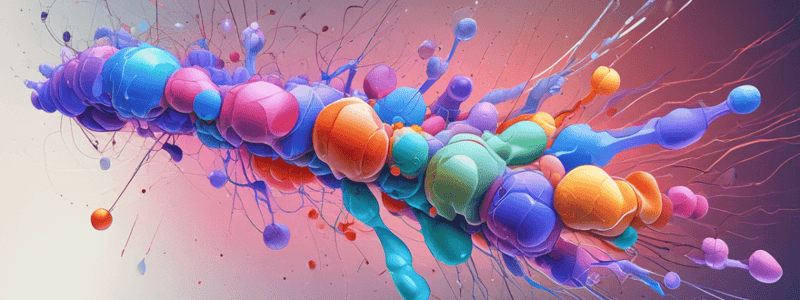Podcast
Questions and Answers
What percentage of drug approvals in 2023 were biologics?
What percentage of drug approvals in 2023 were biologics?
About 50%
Where can a searchable table of antibody therapeutic product data be found?
Where can a searchable table of antibody therapeutic product data be found?
What is the approximate percentage of antibody approvals in 2023 for cancer indications?
What is the approximate percentage of antibody approvals in 2023 for cancer indications?
Not specified in the text, but can be calculated from the data
What is the title of the presentation from which this data is taken?
What is the title of the presentation from which this data is taken?
Who is the author of the presentation from which this data is taken?
Who is the author of the presentation from which this data is taken?
What is the key difference between monospecific and bispecific antibodies?
What is the key difference between monospecific and bispecific antibodies?
What is the advantage of bispecific antibodies in terms of efficacy?
What is the advantage of bispecific antibodies in terms of efficacy?
What is the significance of tunable stoichiometry in bispecific antibodies?
What is the significance of tunable stoichiometry in bispecific antibodies?
What is an example of a recently approved bispecific antibody in the clinic?
What is an example of a recently approved bispecific antibody in the clinic?
How can bispecific antibodies enable first-in-class therapies?
How can bispecific antibodies enable first-in-class therapies?
What is the potential advantage of bispecific antibodies in terms of increasing therapeutic window?
What is the potential advantage of bispecific antibodies in terms of increasing therapeutic window?
What is the main goal of Mammalian Display Technology in the context of therapeutic antibodies?
What is the main goal of Mammalian Display Technology in the context of therapeutic antibodies?
What is the typical size of a library generated from human donors?
What is the typical size of a library generated from human donors?
What is the potential diversity of semi-synthetic 'Explorer' libraries?
What is the potential diversity of semi-synthetic 'Explorer' libraries?
What is the purpose of the bispecific antibody to FIXa and FX in the context of hemophilia?
What is the purpose of the bispecific antibody to FIXa and FX in the context of hemophilia?
What is the target of the anti-BTN3A antibody in the context of immuno-oncology?
What is the target of the anti-BTN3A antibody in the context of immuno-oncology?
What is the advantage of using Mammalian Display Technology compared to other antibody technologies?
What is the advantage of using Mammalian Display Technology compared to other antibody technologies?
What is the primary goal of the 'EXPLORER' modular antibody platform?
What is the primary goal of the 'EXPLORER' modular antibody platform?
What is the significance of using synthetic CDR1 and CDR2 in the 'EXPLORER' platform?
What is the significance of using synthetic CDR1 and CDR2 in the 'EXPLORER' platform?
How does the 'EXPLORER' platform enable the optimization of any antibody repertoire?
How does the 'EXPLORER' platform enable the optimization of any antibody repertoire?
What is the purpose of selecting antibody diversity mimicking human diversity in the 'EXPLORER' platform?
What is the purpose of selecting antibody diversity mimicking human diversity in the 'EXPLORER' platform?
What is the advantage of using a large modular human library in phage display in the 'EXPLORER' platform?
What is the advantage of using a large modular human library in phage display in the 'EXPLORER' platform?
What is the significance of using human donors in the 'EXPLORER' platform?
What is the significance of using human donors in the 'EXPLORER' platform?
What are the current limitations of immunotherapy, and how can they be addressed?
What are the current limitations of immunotherapy, and how can they be addressed?
What are the unique features of gd T-cells, and how do they contribute to immunotherapy?
What are the unique features of gd T-cells, and how do they contribute to immunotherapy?
What is the current focus of immunotherapy research, and what are the challenges in this area?
What is the current focus of immunotherapy research, and what are the challenges in this area?
What is the significance of approved antibodies as inhibitors of immune checkpoint regulators?
What is the significance of approved antibodies as inhibitors of immune checkpoint regulators?
How do gd T-cells differ from αβ T cells, and what are the implications for immunotherapy?
How do gd T-cells differ from αβ T cells, and what are the implications for immunotherapy?
What is the significance of the prognostic impact of genes and infiltrating immune cells across cancers?
What is the significance of the prognostic impact of genes and infiltrating immune cells across cancers?
Flashcards are hidden until you start studying




